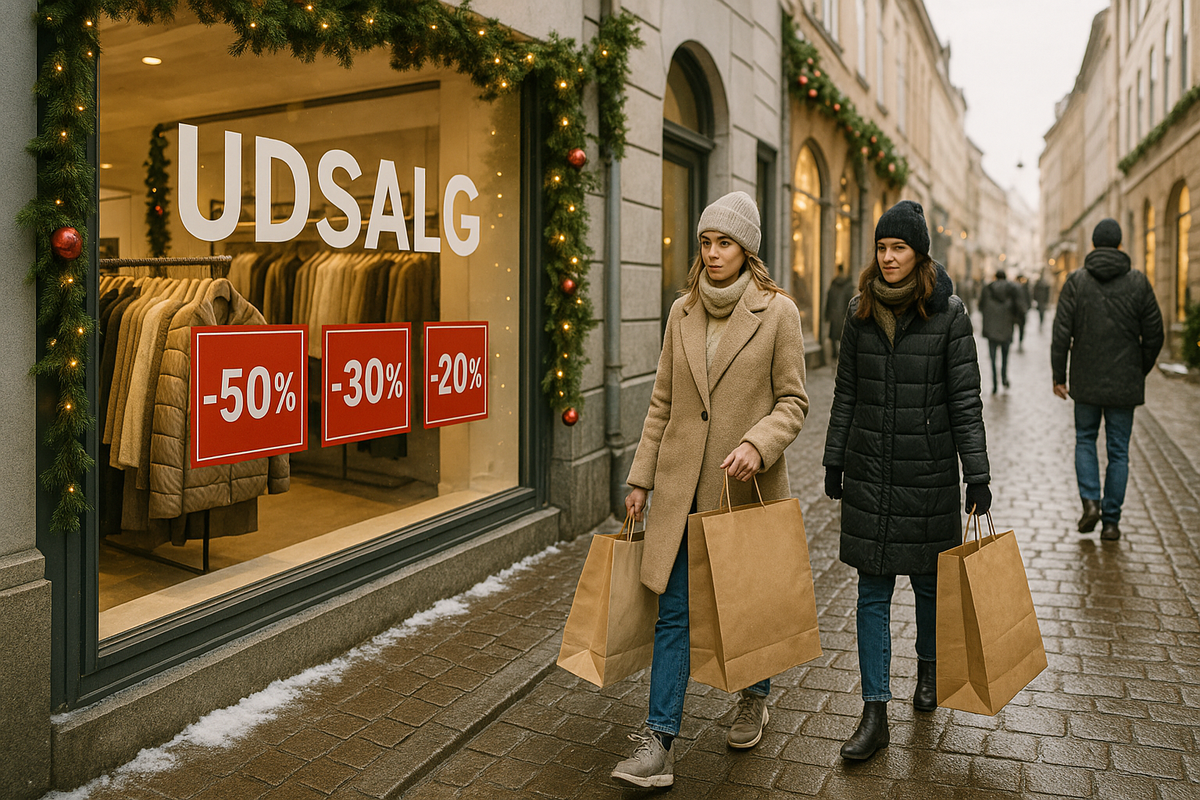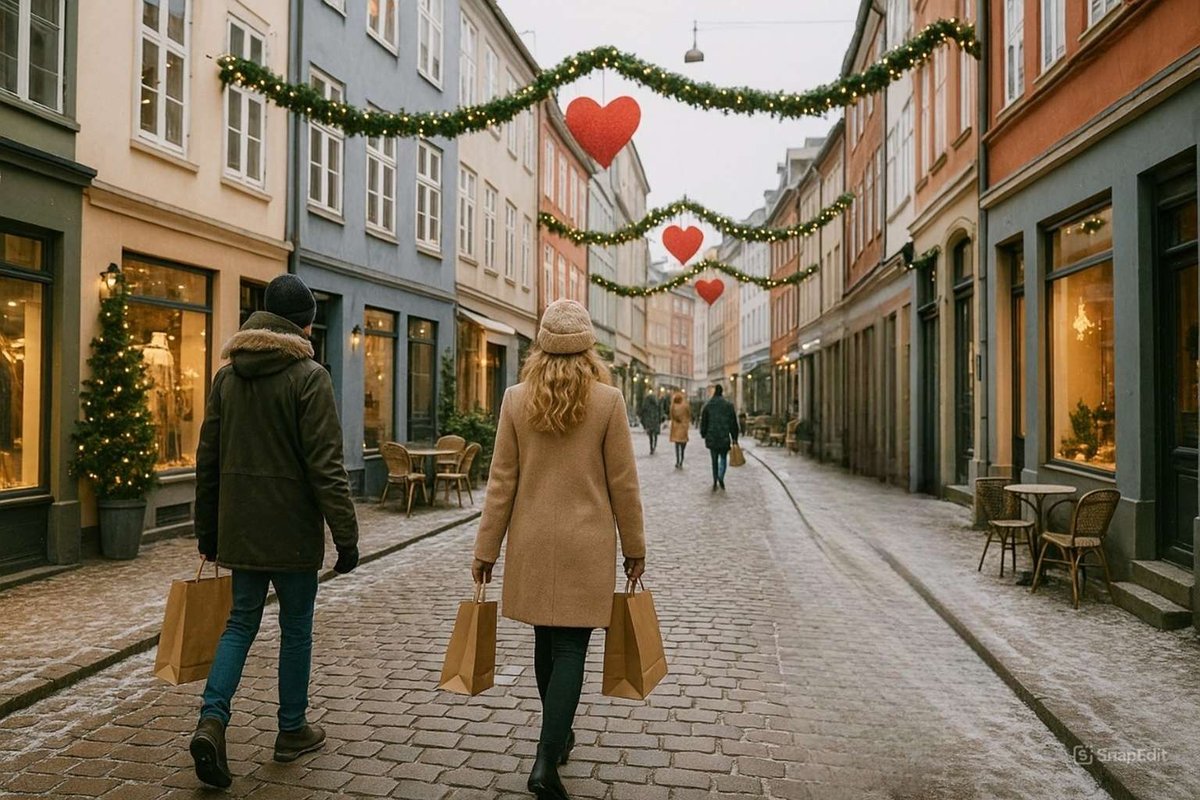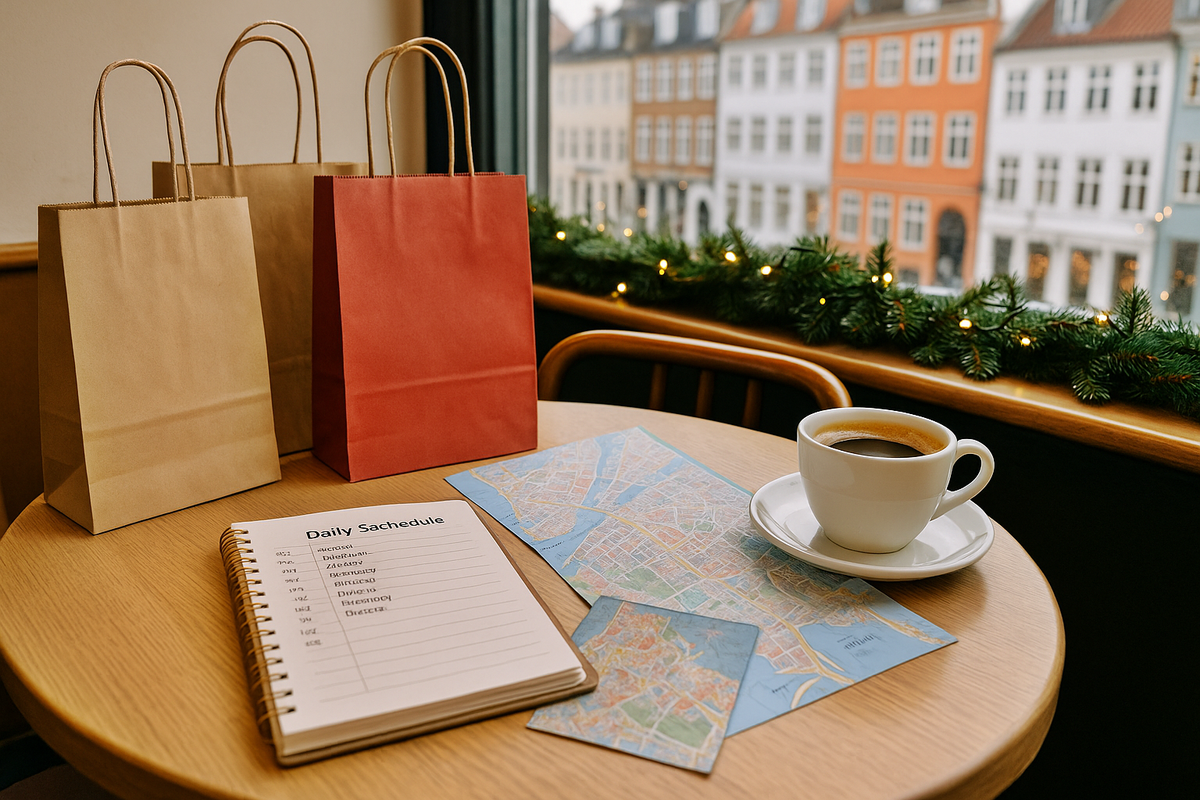🛍️ Shopping plan: Magasin/Illum shop windows, local brands and January sales
Danish winter shopping is not spontaneous purchases between sips of mulled wine and ice skating, but a separate scenario tied to the calendar. 🎄
The main winter udsalg starts right after Christmas and smoothly flows into January: Magasin du Nord and Illum department stores, large chains and malls come into play.
However, 24–26 December are semi-paralysed days: some shops are closed, some are open for very short hours, and small local outlets may not ‘wake up’ until January.
There is a separate category for non-EU residents: formalities, minimum purchase, time at the airport, which must be taken into account so as not to rush to the gate at the last minute. ✈️
📆 Sale calendar: when there are real discounts in Denmark

🧊 24–26 December: ‘holidays, not shopping’
24 December (Juleaften) is the day when the country gathers around the family table: shops close early, and some do not open at all. 25 and 26 December are official holidays; only some supermarkets and duty shops are open, and shopping is hardly a priority.
If your goal is to find sales, not just enjoy the Christmas atmosphere, these dates should be seen as a ‘window for walks and relaxation’ rather than active shopping.
🛒 From 27 December: start of the winter udsalg
From the 27th, large UDSALG signs appear in shop windows in Copenhagen and other major cities, and department stores and chain stores start their winter sales. This is a good time to combine the Christmas atmosphere, the still-up decorations, and the already quite noticeable discounts.
📉 January: peak discounts and the best prices
In January, discounts on a number of categories reach 50-70%, primarily clothing, footwear, and household goods. Later in January, you can catch the tail end of the sales — remaining sizes at the lowest prices; this is profitable, but requires a willingness to settle for a less complete selection.
Approximate roadmap for the period:
| 📆 Period | 🎭 What happens | 👀 What to pay attention to |
|---|---|---|
| 🎄 24–26 December | Holiday long weekend, many places closed | Shopping is secondary, plan for walks |
| 🛍️ 27–30 December | Start of udsalg in chains and department stores | Good balance between atmosphere and discounts |
| 🎆 1–3 January | Sales in full swing | Lots of people, but prices are noticeably lower |
| 📉 Rest of January | Peak and “tail end” of the sales | Best discounts, but fewer sizes/less selection |
Practical formula: if you want both lights and discounts, arrive after 26 December; if you want maximum savings, come in January. 💼
🏬 Magasin and Illum: how to incorporate flagship department stores into your itinerary

🧭 Where they are and why shopping days are built around them
Magasin du Nord is located on Kongens Nytorv, at the beginning of Nyhavn and Strøget, and is actually part of the classic tourist route through the city centre.
Illum is located on Strøget itself, with several entrances and terraces, combining fashion, interior design, cosmetics and gastronomic corners. 🛍️
For tourists, these are convenient ‘one-stop’ spots where you can do the following in one building:
- take care of clothing and footwear needs;
- find Scandinavian textiles and home décor;
- buy cosmetics, souvenirs, and gift sets.
⏱️ Visit format: from a ‘quick stop’ to 2-3 hours
A rational tourist does not simply plan to ‘pop into Magasin,’ but chooses the format of the visit:
- A quick stop for 45-60 minutes. Specific goal: shoes, outerwear, cosmetics of certain brands. Scenario: a clear list, 1–2 floors, no window shopping.
- 2–3 hours with fittings and coffee. One large shopping slot in the day. Allow time for fitting rooms, queues and a short break in a café inside or near the department store.
The optimal time slot is midday: in the morning, you can walk around the area, and in the evening, you can enjoy dinner and the city lights without leaving the shops with heavy bags.
🎯 What makes more sense to buy in department stores
Department stores win where the following are important:
- a wide range of sizes for a single model (shoes, basic clothing);
- a concentration of brands in a single category (cosmetics, skincare, perfume);
- interior design and tableware in the mid-price segment, where it is convenient to compare on the spot.
Places with more ‘distinctive’ designs (vintage, small ceramic studios, posters) are easier to find in local shops rather than in Magasin/Illum.
🌆 Local brands and neighbourhoods: shopping as part of a walk

🚶 Routes through neighbourhoods instead of rushing around shopping centres
To avoid turning your trip into a continuous tour of shopping centres, it makes sense to link shopping to walking areas:
- Strøget + side streets — concept stores, Nordic clothing, minimalist interiors.
- Vesterbro — a mix of small designer shops and cafes.
- Nørrebro — a more ‘youthful’ vibe: vintage, posters, independent brands.
- Østerbro — quiet, family shopping: children's shops, interiors, local bakeries.
Working scenario: in the morning, a walk around the area with stops at local shops; in the afternoon, one large department store or mall; in the evening, dinner and a walk without shopping bags.
🧵 What local formats are worth looking for
It makes sense to divide local brands into several typical categories:
- Nordic clothing and footwear brands (casual, outdoor, knitwear);
- ceramics and studio porcelain;
- textiles and posters for the home;
- small design objects and gifts in the spirit of hygge.
The goal is not to see all the shops in the area, but to ‘catch’ 2-3 spots that fit your style and budget.
💰 Tax Free in Denmark: basic rules for tourists

📄 Conditions and minimum amount
For non-EU residents, a portion of VAT (Tax Free) is refunded when goods are taken outside the European Union.
Basic points to keep in mind:
- the standard VAT rate in Denmark is 25%;
- Tax Free is only available for purchases above a certain threshold in one shop per day (aim for around 300+ DKK per receipt);
- not all shops participate — the logos of the operators (Global Blue, Planet, etc.) are usually displayed on the doors and at the cash registers.
At the checkout, you need to say immediately that you need Tax Free, show your passport and check that the form is filled in correctly.
✈️ What to do at the airport: timing and steps
At Copenhagen Airport, the refund process usually looks like this:
- Arrive at the airport at least an hour earlier than you would have arrived without Tax Free.
- If the goods are large/expensive (electronics, outerwear), be prepared to show them to customs before checking them in.
- Have the customs stamp placed on the Tax Free forms.
- Submit the documents to the operator (Tax Free counter/kiosk) and choose the refund method: cash, card, or sometimes a refund to your account.
In total, it can easily take 30-60 minutes to get a refund for several receipts, especially during the high season.
The logic is simple: it is better to allow time and calmly drink a coffee after completing the paperwork than to stand in line at the Tax Free counter, watching the boarding timer.
📊 What purchases really ‘work’ with Tax Free
Tax Free makes the most sense:
- when buying clothing and footwear in the mid-range and above price segment;
- for technology, design objects and more expensive decor;
- for several large receipts, where the refund adds up to a significant amount.
For small purchases (souvenirs, individual candles, small ceramics), collecting receipts and standing in line often does not justify the effort.
📋 Practical shopping plan for 1–2 days

📆 Day 1: city centre, shop windows and ‘core’ purchases
Morning:
- Check in or drop off your belongings in a luggage storage facility.
- Walk around the city centre and Strøget without trying to ‘run into everything at once’.
Day:
- Magasin du Nord and/or Illum as the key shopping block.
- Focus on large purchases (shoes, outerwear, interior design, cosmetics), where it is important to try things on and compare options.
Evening:
- Coffee or early dinner nearby, walk around the illuminated city centre without any plans to shop.
🧭 Day 2 (half day): local brands + completing the checklist
Morning:
- Walk around the chosen area (Vesterbro, Nørrebro, Østerbro) with stops at 2-3 local shops.
Day:
- Finishing off the list: anything you didn't have time to buy the day before.
- At the hotel — final packing of purchases, sorting receipts, checking that all Tax Free forms are in place.
Evening / day of departure:
- Arrive at the airport with plenty of time to spare: standard time + at least 1 hour for Tax Free.
- Check in your luggage, go through customs, visit the Tax Free counter, and then you can relax and wait for your flight.
🚦 Risk management: how not to turn sales into stress

For your shopping plan to work, it's worth agreeing on a few rules in advance:
- Don't plan key purchases for 24–26 December — on these days, it's the atmosphere that matters, not the range of goods on offer.
- Don't leave Tax Free for the last minute — refunds always take longer than planned.
- Don't plan a ‘shopping marathon’ — it's better to have a clear list + 1–2 large blocks than to wander around shops chaotically all day.
- Allow for buffers — in queues for fitting rooms, cash registers and VAT refund counters.
The final principle is simple: sales and Tax Free should work for your itinerary, not dictate it. If you understand the discount calendar, the city's layout and the VAT refund requirements in advance, shopping in Denmark becomes straightforward, manageable and without any unnecessary surprises.
❓FAQ
💬 It is best to plan your trip for after 26 December or in January, when the winter udsalg sales are in full swing and the city is back to normal.
💬 Many shops are closed or have very limited opening hours on these days, so it is best to consider them as a time for walking around rather than serious shopping.
💬 It is more convenient to buy mid-range clothing, footwear, cosmetics and interior items at department stores, and ceramics, posters, small design items and local brands at neighbourhood shops.
💬 Non-EU residents can apply for Tax Free on purchases above a minimum threshold in one shop, and you need to arrive at the airport at least an hour earlier than usual to have time to go through customs and the refund desk.
💬 It is more practical to plan 1-2 structured shopping blocks (for example, a day in the city centre + half a day in the suburbs) and not try to ‘buy everything on the way’ so as not to turn the trip into a haphazard shopping spree.





0 comments
Log in to leave a comment